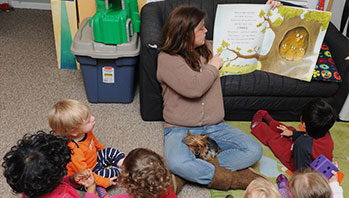- engine
- machine
- move
- train
- wheel
MA Standards:
English Language Arts/Literature/RL.PK.MA.1: With prompting and support, ask and answer questions about a story or a poem read aloud.
English Language Arts/Literature/RL.PK.MA.4: With prompting and support, ask and answer questions about unfamiliar words in a story or poem read aloud.
English Language Arts/Literature/RL.PK.MA.9: With prompting and support, make connections between a story or poem and one’s own experiences.
English Language Arts/Literature/RL.PK.MA.2: With prompting and support, retell a sequence of events from a story read aloud.
English Language Arts/Language/L.PK.MA.1.e: Use the most frequently occurring prepositions (e.g., to, from, in, out, on, off, for, of, by, with).
Head Start Outcomes:
Literacy Knowledge/Alphabet Knowledge: Recognizes that the letters of the alphabet are a special category of visual graphics that can be individually named.
Literacy Knowledge/Book Appreciation and Knowledge: Asks and answers questions and makes comments about print materials.
PreK Learning Guidelines:
English Language Arts/Reading and Literature 7: Develop familiarity with the forms of alphabet letters, awareness of print, and letter forms.
English Language Arts/Reading and Literature 6: Listen to a wide variety of age appropriate literature read aloud.
English Language Arts/Reading and Literature 10: Engage actively in read-aloud activities by asking questions, offering ideas, predicting or retelling important parts of a story or informational book.
Read Together: The Little Engine That Could #1

© Commonwealth of Massachusetts, Department of Early Education and Care (Jennifer Waddell photographer). All rights reserved.
STEM Key Concepts: Identify tools and simple machines used for a specific purpose
ELA Focus Skills: Active Listening, Compare and Contrast, Story Comprehension, Vocabulary
Before You Read
Hold up the cover of The Little Engine That Could by Piper Waddy. Have children locate the title and the names of the author and illustrator. Review what an author and illustrator do.
Ask children to name any objects on the cover that they recognize.
- Point to the train engine and explain how a train is a machine that helps move people and things from one place to another.
- Point to the train’s cargo and discuss with children what the train is carrying.
- Set a reading focus for children as you have them listen for reasons the engines cannot pull the train over the mountain.
As You Read
Read with expression.
Pause to review plot events and help children make connections to their explorations this week:
- On p. 12, say, Why do you think the little train stopped as she was taking the toys to the boys and girls on the other side of the mountain?
- Why do you think the little train’s wheels wouldn’t turn?
- On p. 13, ask, Do you think the train is moving fast? What might make it move fast? (wheels, mountain/ramp, track)
- On p. 26, ask, What do you notice about the Rusty Old Engine’s wheels? How do you think this engine moves along the track?
Talk about unfamiliar vocabulary words such as bellow and freight. On p. 21, read the sentence with the word bellow in it. Point to the illustration and ask, What kind of sound do you think this train would make? (elicit loud, booming, etc., and define the sound as a bellow) Have children make a bellow.
After You Read
Talk with children about the story. Ask questions such as,
- Did you like the story about the little engine? Why or why not?
- Why was it so hard for the little train to get help?
- What do you think it would be like to pull the toys over the mountain? Have you ever pulled something heavy up a hill? Have children share their experiences or offer one of your own.
Adaptation: If younger children have trouble concentrating, paraphrase the story to make is shorter.
English Language Learners: Before reading, use facial expressions, movements, and gestures to demonstrate the meaning of words. Then have children act out the words as you arrive at them in your reading.
